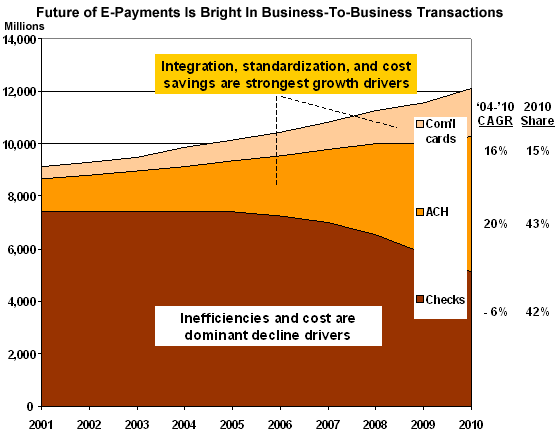Business-to-Business Payment Systems: Does Reality Byte?
Abstract
San Francisco, CA, USA February 13, 2002 ?Whatever happened to the rosy picture of paperless payment systems that large corporations and financial institutions began to paint with the advent of financial electronic data interchange, automated clearing houses (ACH), and wire transfers? In a new report,Business-to-Business Payment Systems:Does Reality Byte? Alenka Grealish, analyst at Celent Communications, examines the status and future of electronic payments in business-to-business transactions, on- and off-line. Despite the success of paperless payments in Europe, the check continues to be the payment vehicle of choice in the U.S.Of the nine billion of B2B payments made in 2001, 82% were made by check, while of the US$31 trillion in B2B payments, 65% was accounted for by checks.ACH payments were a distant second with 13% and 34%, respectively. The greatest impediment to the adoption of electronic payment vehicles is not the settlement system (e.g., ACH) but lies further upstream.For any electronic payment solution to succeed, it must be integrated into the broader financial supply chain, comments Grealish.Consequently, solutions involve not only banks but also software vendors, which are automating the financial supply chain.Ultimately, the future of electronic payments resides with the businesses themselves and depends upon their willingness to restructure the payment processes and systems around an electronic solution. Despite the success of paperless payments in Europe, the check continues to be the payment vehicle of choice in the U.S.Of the nine billion of B2B payments made in 2001, 82% were made by check, while of the US$31 trillion in B2B payments, 65% was accounted for by checks.ACH payments were a distant second with 13% and 34%, respectively. The greatest impediment to the adoption of electronic payment vehicles is not the settlement system (e.g., ACH) but lies further upstream.For any electronic payment solution to succeed, it must be integrated into the broader financial supply chain, comments Grealish.Consequently, solutions involve not only banks but also software vendors, which are automating the financial supply chain.Ultimately, the future of electronic payments resides with the businesses themselves and depends upon their willingness to restructure the payment processes and systems around an electronic solution. "The migration of B2B payments to electronic channels in the U.S. will be an evolutionary process," says Grealish. "There are no revolutions in the wings. Gradually propelled by both bank and non-bank initiatives to automate the financial supply chain, electronic payments will overtake the check in terms of total value of transactions by 2008. In terms of volume, the check will continue to reign through the end of this decade. Amongst the electronic payment catalysts covered by Grealish are:enhanced purchasing cards (e.g., MasterCard SmartLink), the coupling of ACH payments with rich remittance information (e.g., Clareon and Xign), electronic bank addresses (New York Clearing House Associations UPIC), the opportunity to outsource payment processing (e.g., SurePay), and the enabling of straight-through processing (e.g., Identrus Project Eleanor and Clarus Settlement). A Table of Contents is available online. |
of Celent Communication's Wholesale Banking research service can download the report electronically by clicking on the icon to the left. |
|

